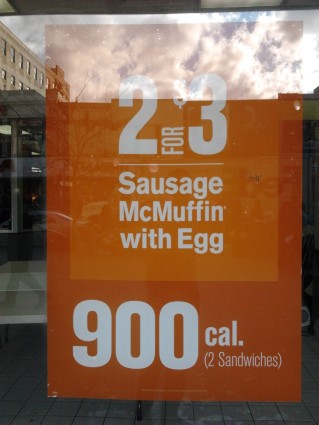So after talking about how big beverage corporations have been targeting their marketing campaigns towards young people, and discussing how the Bloomberg administration has been using an advertising campaign to combat overconsumption of these sugary beverages, I think it’s worth examining a more recent battle of food campaigns. The issue/mini case study at hand: calorie counts.
At some point recently when you were out ordering food, you might have noticed that there were calorie counts on the menu. This was not an idea developed by restaurants themselves (shocker!) but rather was a regulation passed in 2008 by the Bloomberg administration requiring chain restaurants with at least 15 different stores to post the calories of their products.

That looks like a lot of calories! (via SeriousEats)
The idea seems simple enough: many of these chain restaurants are serving unhealthy fast food. If you make consumers aware of how many calories are in, say, a Big Mac, then perhaps they might be persuaded to select a more healthy item, or perhaps go to another restaurant all together. In a city press release earlier this year, NYC Health Commissioner Thomas Farley trumped the core idea behind of this program:
By requiring fast food chains to post the amount of calories in food items, we’ve made it easier for New Yorkers to make more informed choices about the food they eat. This customer survey shows that people who are taking calorie counts into account when they order are purchasing fewer calories as a result. (via NYC.gov)
The same press release also showed off some promising statistics related to this program:
One in six customers (15%) reported using the calorie information to make their purchase, and these customers purchased an average of 106 fewer calories. (via NYC.gov).
So, you may be wondering at this point, “Where is the dark side?”
While the press release touts the positive effects that the calorie count is having, nowhere does it mention low-income families, the poor, or those living in poverty. In an op-ed written in the New York Times over the summer discussing the pros and cons of the calorie counts, Adam Drewnowski, the director of the University of Washington Center for Obesity Research, described the impact that calorie counts might be having on lower-income people:
“Stuff your face with value.” That is the unintended message that posted calorie counts convey to the average consumer. Having calories posted along with prices makes it absurdly easy to see which menu options provide plenty of calories per dollar and which do not. So if you are hungry and one $5 sandwich has 580 calories and the other one only 230, what is your choice? A meatball marinara footlong with cheese is my rational economic decision — and hold the lettuce.
It is about the money and wanting better value. For upper-income consumers, value can mean more anti-aging nutrients in the foods they eat. By contrast, lower-income consumers sometimes say that the only label they look at is the one that says 79 cents. For them, more calories per dollar means more satisfaction until the next meal. (The New York Times)
Drewnowski makes an excellent point by describing this “unintended message” of calorie counts. But is this effect happening naturally, or have fast food and chain restaurants found a way to capitalize on this phenomena? This poster in the window at the McDonald’s near by office certainly swayed my thinking:
The numbers that pop out immediately are the number of sandwiches (2), the price, ($3), and the calories (900). One might initially think that McDonald’s would try to hide the high number of calories in their products, but in fact, it seems as if they’re using the calories to promote them.
For those without a lot of money who are looking for a big meal, it is hard to beat 900 calories for $3. Could the requirement to post calorie counts actually be making certain populations less healthy?
This, if you ask me, is the dark side of a food campaign.
Any ideas on ways to tweak this policy in such a way that it promotes healthy eating choices across all levels of income? Share your thoughts in the comments!

Posted by bodhiblogger on December 4, 2011 at 10:56 pm
Thanks David for blogging about this issue and giving a voice to people who deserve healthy eating choices.
Posted by bodhiblogger on December 4, 2011 at 11:00 pm
Are there any food campaigns to promote green markets in low income neighborhoods in the city? Maybe you can blog about this?
Also I remember in the Fast Food Nation film, they talked about how in some schools they were advertising for fast food and soda companies. Are there any laws that have challenged this?
Posted by Average Joe on December 12, 2011 at 2:13 pm
Yes, the poverty stricken are a nuisance with their enforced thrift, their inability to contribute to the commerce of overpriced conspicuous consumption. The McD advertising makes a ton of sense for the restaurant chain and for a market segment they alone cater to. If you think advertising is foolproof in its function, try advertising your snobby knobby heirloom tomatoes at $5.00 each or your basic organic pork chops at $25.00 a pound and see how frantic customers break down your doors to get at those bargains. I swear some people live secluded in a protected little Oprah bubble. OH, well, prattle on, girls!